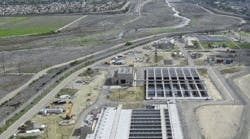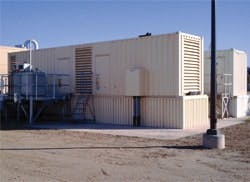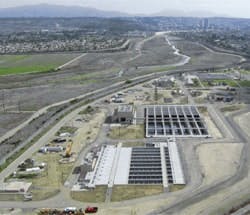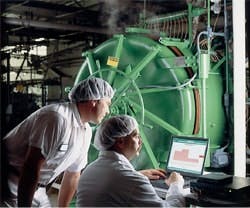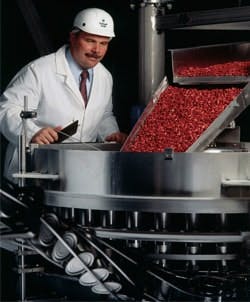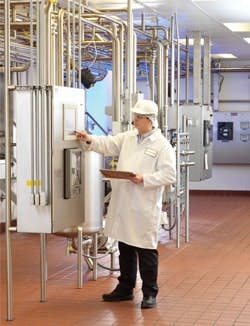Plant upgrades and overhauls mean involving the engineering department and having the foresight to not only change what is lacking, but plan for future needs, as well. Three plants took advantage of facility modifications and parlayed them into better maintenance and reliability.
In the first example, the addition of secondary wastewater treatment necessitated an upgrade in emergency standby power, which meant installing a new system that matched the existing one. The improvement allowed the treatment plant to meet EPA standards and gave it the backup power it required in the event of an outage.
Equipment stress protection made a difference in the second example, in which a firearm manufacturer increased reliability and productivity by implementing functional interface stress hardening. Engineering, operations, and maintenance personnel’s ability to work and plan together allowed the facility to mitigate equipment downtime.
Finally, when a food production plant had expanded to the point where it was unequipped to handle the breadth and volume of its products, a complete facility overhaul allowed for more efficient operations and the plant moved to a predictive maintenance strategy.
Stand by your power
Built in the late 1990s, the South Bay International Wastewater Treatment plant is a joint effort between Mexico and the United States to treat sewage from Tijuana, Mexico, and eliminate environmental concerns in the Tijuana River Valley just south of San Diego. The plant is located on a 75-acre site in the United States just north of Tijuana. The International Border and Water Commission (IBWC, www.ibwc.gov), the plant’s operator, needed to add secondary treatment to improve the quality of the discharge water.
The South Bay wastewater treatment plant has a capacity of 25 million gal/day. Its original design consisted of advanced primary treatment, which involved the addition of chemicals to the influent to promote removal of solids and dissolved organic compounds through settling. The treated water was then discharged via a 4.5-mile pipe extended out into the Pacific Ocean near the Mexico-California border. When the quality of the advanced primary treated discharge was found not to meet current environmental standards set by the EPA, the IBWC decided to add secondary treatment to the plant.
Secondary treatment involves bacteria-activated sludge combined with aeration and additional settling. Encouraged by the large supply of oxygen bubbled through the sewage, aerobic bacteria consume the remaining organic compounds in the effluent. The sludge is then removed by additional settling and then recycled to reuse the bacteria. After secondary treatment, the water quality is much improved and meets EPA standards. Adding secondary treatment has greatly increased the plant’s electrical load. The large aeration pumps and activated sludge system necessitated the addition of another 2,000 kW of emergency standby power, so the plant turned to MTU Onsite Energy (www.mtuonsiteenergy.com).
“The plant hasn’t been expanded in terms of overall capacity,” says Steve Smullen, area operations manager, IBWC. “It was originally designed for both advanced primary treatment and secondary treatment, but the secondary facilities were not immediately funded. Recently, we got the funding, and now we’ve added a biological system, aeration and settling facilities to meet our EPA permit requirements. As a consequence of completing the secondary treatment, we also added quite a bit of additional electrical load to the plant to operate three 700 hp aeration blowers and related equipment. In case of a utility outage, we needed the additional standby generation to handle those larger loads.”
Figure 1. The South Bay International Wastewater Treatment plant found a challenge in getting the two generators to fit into identical packages.
The treatment plant wanted the new power system installation to physically match that of an existing 2,000 kW generator that was installed during the original construction in the late ’90s, says Tim Oergel of W.W. Williams, the local distributor for MTU Onsite Energy. “Getting the two generators to fit into identical packages was a challenge,” he says (Figure 1).
One design issue was that the MTU Onsite Energy unit was 16 years newer than its companion, which was from a different manufacturer. The new unit operates at 12.47 kV housed in a specially designed ISO container. This newer generator set is EPA-certified to meet Tier 2 emissions regulations, whereas the existing generator set was manufactured at the beginning of Tier requirements and was compliant with, but not EPA certified to, Tier 1 standards.
In addition to not having modern emissions control hardware, the existing generator drive engine set did not have an electronic governor or other electronic controls to help it synchronize with the new generator drive engine. To get the two generators to communicate with each other, the existing generator’s governor was replaced, along with many other controls. The overhaul also included new paralleling switchgear, automatic transfer switches, and various communications interfaces.
{pb}“While the MTU Onsite Energy EPA-certified Tier 2 generator set is more fuel efficient and has significantly cleaner exhaust, it also has higher heat rejection that requires a specialized radiator,” says Oergel. “Because we had to match the size of the original 40-ft ISO container, we had to be creative in designing a radiator with higher heat rejection to fit in the same-sized package as the original generator set. The solution was a specially designed radiator from R.F. Partridge & IEA Radiator that was direct-driven through a planetary gear off the engine’s crank shaft. With a larger surface area and greater airflow, the special radiator was able to fit inside the container and still provide the necessary cooling.”
Figure 2. The plant is located in earthquake country, so the generator set containers are supported by a seismically reinforced mezzanine structure consisting of I-beams connected in crisscross patterns.
The physical installation of the containers is unique, as well. Each containerized generator set is mounted on a concrete pad outside of the plant’s main building. Because the plant is located in earthquake country, both generator set containers are supported by a seismically reinforced mezzanine structure consisting of I-beams connected in crisscross patterns (Figure 2). These structures support the weight of the containers and are bolted to the concrete pad to prevent damage to the generators in the event of an earthquake.
“MTU Onsite Energy was successful in winning the project due to a combination of our EPA-certified Tier 2 emissions rating, good pricing and higher average load-factor capabilities. During extended outages, the MTU generator set can supply 15% more kW.”
Installation, final commissioning and load-bank testing were completed in the summer of 2010 to make sure that both units could carry the full plant’s load while operating in parallel. “Getting the different units to operate together was a challenge,” says Oergel. “There were many sequence-of-operation changes that were needed to make sure both units functioned properly and could carry the load. But now the plant is assured of having emergency power for all its critical loads in the event of a utility outage. That will allow this joint U.S.-Mexico wastewater treatment plant to continue to fulfill its mission of protecting the environment throughout the Tijuana River Valley and Southern California.”
Teach a maintenance engineer to FISH
Sturm Ruger (www.ruger.com) manufactures American-made firearms for the commercial sporting market, offering more than 400 variations on more than 70 products across 25 product lines. Its main rifle and pistol components manufacturing plant in Newport, New Hampshire, is more efficient and profitable today than it was in 2007 because of a proactive maintenance department and a vice president of operations who understands the value and the necessity of reliable equipment.
In 2007, with unscheduled downtime on the automation and manufacturing controls and CNC machine tools, David Ford, the hydraulic maintenance specialist, requested a portable oil filtration system to cut down on hydraulic oil contamination, save some money on oil costs, and, hopefully, boost machine uptime.
Tom Sullivan, vice president of operations at the Newport plant, thought it was a good idea, but not all oil filter systems are equal. He already knew Howard Cooper at Amemco (www.amemco.net), and thought Cooper could help his team get it right and show other stress protection methods that increase uptime and machine and control reliability.
[pullquote]Sturm Ruger brought Cooper in to prepare a plant-wide equipment survey and conduct an orientation seminar on functional interface stress hardening (FISHing). These meetings involved the maintenance and manufacturing engineers, plant management, and maintenance specialists to hear Cooper explain how to replace preventive maintenance with condition-based maintenance (CBM) and how to maximize uptime and equipment reliability by going FISHing.
Cooper’s facility and equipment survey revealed one root-cause stress to be frequent power surges and voltage transients that were affecting CNCs, PLCs, computer and electronic controls, and drive systems. The survey identified and prioritized other root-cause stresses and resulted in a machine-by-machine stress protection solutions report (FISHing report). This document served as a stress-hardening protection recommendation and installation guide.
Kim White, Sturm’s maintenance manager, authorized Bill Ross, Sturm’s maintenance electrician, to begin testing the proposed solutions listed in the FISHing report. The initial testing involved installing high-speed clamping/filtering transient voltage surge suppression (TVSS) units from Total Protection Solutions (www.tpssurge.com) and air-to-air heat exchangers on two Portland reamers in the gun forge molding department.
Historically, Sturm Ruger was replacing at least one of these motion axis drives every other month and experiencing the loss of production. Since the replacement, there have been no costly axis drive replacements needed and no scrap being generated from marginal and failing axis drives.
{pb}Summer heat also was affecting the company’s Technidrills and Extrom Carlson CNCs in the woodworking department. Frequently the cabinet doors were left open to keep the controls from malfunctioning or failing. The FISHing report included the size and type of control coolers to use, the proper connection points, and mounting details for the TVSS devices. The woodshop hasn’t experienced downtime or quirky malfunction problems since making the changes.
Considering the cost of lost production and unrecoverable lean manufacturing profits stemming from CNC machine downtime, three years’ worth of the savings is probably more than the cost of the CNC machine tools.
Based on these pilot-test results, Sturm Ruger began implementing the FISH report suggestions across the manufacturing facility. “From the time I started with Sturm Ruger back in 2003,” says Ross, “at least once or twice a week you’d hear from a CNC operator that the machine had just stopped or wouldn't start up correctly. We’d have to shut off the main power switch feeding the machine tool and turn it back on again to reset or reboot it. That seemed to fix the problem until the next occurrence. Since completing this equipment stress protection project, I’ve not heard of that happening again.”
The overall effect was like installing a large UPS on every machine tool, but the real savings came from increased reliability, productivity, and uninterrupted profits.
Shortly after restructuring maintenance, the concepts and methods of the original project were expanded to include additional machining and process control areas, as well as TPS suppressors to protect Sturm’s low-voltage lighting. These expanded efforts have maximized plant uptime and equipment reliability. “In addition,” says Ross, “it’s now standard policy that when we add any new piece of equipment in the Revolver Group, we immediately purchase and install the TPS high-speed TVSS and other FISHing gear.”
Food production overhaul
Figure 3. Faribault Foods needed a modern production infrastructure that delivered efficient, reliable, and sustainable operations.
For all manufacturers, regardless of industry, sustainable production practices are no longer nice-to-have – they’re a business imperative. And for food and beverage companies in particular – which the U.S. Energy Information Administration ranks as one of the top five most energy-intensive types of manufacturing – implementing efficient manufacturing practices can mean both improving the quality of life for customers and driving savings to their own bottom line.
Minnesota-based Faribault Foods (www.faribaultfoods.com) is no stranger to the importance of sustainability in food production. As a producer of many foods including a wide variety of beans, chili, organic soup, juices, and canned pasta, Faribault Foods is a member of the Sustainability Initiative Team (SIT), a part of the Foundation for Strategic Sourcing. The group is comprised of executives from major consumer packaged goods, contract manufacturing, and packaging supplier companies that work together to develop industry standards to promote sustainability (Figure 3).
“Our customers definitely are paying more attention to sustainability,” explained Scott King, executive vice president of operations, Faribault Foods. “Our participation in groups like SIT helps us understand the importance – both financially and in terms of responsible corporate citizenship – of greening the entire food supply chain.”
While business drivers might have progressed in recent years, the bean production process hasn’t changed much in the company’s 115-year history. Beans come to the primary production facility from all over the Midwest. They’re placed into a soaking and rehydration system, and then blanched and transferred to a canning line, where broth, sauce, or brine is added for flavor. The cans are sealed and sent to the cooking system, where they’re held at a particular temperature to make them a commercially sterile product. Finally, the cans are cooled, packed on pallets, and shipped to thousands of retail locations across the country.
“The Faribault bean plant was designed as a seasonal vegetable canning facility,” explains Phil Hines, director of engineering, Faribault Foods. “When I joined the company in 2005, it was being operated year-round as a rehydrated bean canning facility. We needed to modernize our production infrastructure to meet long-term business goals and deliver the high-quality, sustainable products our customers expect.”
{pb}Figure 4. The control system monitors the entire production infrastructure in real-time, including WAGES consumption information, allowing the Faribault Foods team to identify opportunities for improvement.
With several hundred varieties of product going through the facility each year, it simply wasn’t designed to keep pace with the company’s growing business. In addition to producing several of its own brands, such as Butter Kernel, Kuner’s, S&W Beans, and Chilliman, the company also produces private-label brands for many large grocery retailers, and provides copacking, or contract manufacturing services as well. “We needed to demonstrate and document reliable, repeatable production practices to our customers – particularly to those working with us on copack products,” explains Hines. “Our existing production infrastructure didn’t allow the necessary level of data collection and insight; plus, it was simply less efficient to run in terms of water, air, gas, electric, and steam (WAGES) resource consumption (Figure 4).”
Once the company decided to invest in a complete facility overhaul, Hines and his team designed a comprehensive plan to identify opportunities for improvement, documentation requirements, and an ongoing timeline for implementation. “We knew this wasn’t going to be a one-time effort,” explains Hines, who, along with his team, selected a process solution based on the Rockwell Automation Integrated Architecture system, featuring eight Allen-Bradley ControlLogix programmable automation controllers (PAC). Each PAC communicates via a ControlNet network to intelligent field devices and twelve human-machine interface stations comprised of Allen-Bradley PanelView Plus terminals and industrial computers running FactoryTalk View SE software. The control system monitors the production infrastructure in real-time, including WAGES consumption information, so Hines and his team can identify opportunities for improvement quickly and document each critical step of the process. Faribault Foods implemented instrumentation from Rockwell Automation PartnerNetwork member Endress+Hauser for seamless integration with the Rockwell Automation equipment the application uses. “When we started this project, we were in the beginning stages of automating of our production system,” explains Hines. “As a result, this project represented a substantial technology change for the maintenance department. The biggest challenge was training. Every maintenance person needs to understand the functionality of the new sensing and controls devices in order to troubleshoot their operation and to be able to differentiate between control system issues and mechanical issues. We implemented a training program for all maintenance staff and specialty training for a selected group who would focus on maintaining and updating the new control systems.”
As part of the project, Faribault standardized many of the devices, says Hines. “For example, we use the same VFD model throughout the facility,” he explains. “This reduces the installation and setup time by having only one procedure. We also included electronic documentation of the location, description and function of each device and the ability to allow outside vendors to access our system through a VPN connection for data collection and troubleshooting.”
Faribault Foods won several awards for its commitment to sustainability. The solution also includes more than 60 Allen-Bradley PowerFlex variable frequency drives for more intelligent motor control throughout the plant. The drives improve equipment efficiency by adjusting cycle speeds as needed rather than running at full capacity at all times. In addition, the drives feed critical motor data back to the central control system for improved maintenance capabilities.
To ensure a smooth transition, Hines wanted to train his staff on the new technology as soon as the system was online. “Previously, one or two staff members possessed 90% of the control system knowledge,” he says. “With the new system, we wanted to make sure everyone understood how it worked.” By partnering with Rockwell Automation, Werner Electric (a local authorized Allen-Bradley distributor) and Alexandria Technical College, plant-floor staff receives training on everything from basic maintenance and troubleshooting, to servo control and the company’s latest software implementation.
The Allen-Bradley controls are running the company’s heat and energy-recovery system, which reuses 100% of the heat from the can cooling process to warm city water for the soaking, blanching, and cooking operations. The result is a 38.2% decrease in natural gas usage, which won the company Xcel Energy’s 2009 award for the largest natural gas reduction among industrial customers in the state of Minnesota. In addition, the system reuses cooled water to reduce the temperature of the cans in the cooking process, which cuts down on the company’s overall water usage by more than 100 million gal/year.
Figure 5. Tighter control of the process also allows for reduced waste in the manufacturing process.
Tighter control of the process also allows for reduced waste in the manufacturing process (Figure 5). To accommodate the cooking process, the company leaves “head space” in each can – essentially an air pocket between the can lid and the beans. Previously, at the end of the manufacturing line, the head space would be pushed out along with a few ounces of canning fluid, which would be flushed down the drain. Now, thanks to the increased process accuracy and reliability, the plant-floor team can fill to exact levels, ensuring that no fluid is wasted when the head space is forced out of the can.
The new system also provides the company with an unprecedented level of process documentation, which has helped it achieve Safe Quality Food (SQF) accreditation at its three plants. According to the SQF website, SQF accreditation is a voluntary program designed to address heightened consumer demand for increased food safety. To comply with SQF standards, companies such as Faribault Foods must provide verifiable proof its robust food-safety control systems have been implemented, validated properly, and that they leverage continuous monitoring procedures. “Without the Rockwell Automation control system, we simply wouldn’t have possessed the documentation necessary to achieve SQF validation, which many of our customers require,” explained Hines.
As Faribault Foods moves to a predictive maintenance strategy, the asset management and training support also are proving useful. Faribault Foods is now producing the same amount of product in five days that previously required seven. When Hines first started the upgrade process, the plant typically was running at 75% of its maximum throughput. Now, the facility runs at 90%, with a better product quality, as well.
“We’re constantly improving our production processes, not only at our Faribault location but also at our Elk River and Cokato plants,” says Hines.
